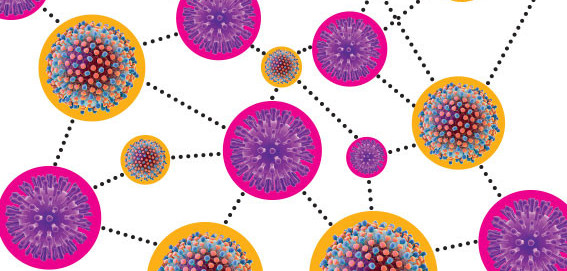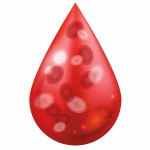Not surprised, yet still rather shocked. That was Ian Finkenbinder’s reaction to testing positive for hepatitis C virus (HCV) in 2012.
The 36-year-old, who was designated male at birth and identifies as a nonbinary trans girl, had been diagnosed with HIV in 2009. During the time between these two diagnoses, the Seattle resident, who opts for they/them pronouns, had become addicted to crystal meth, which they injected.
Hep C, an insidious infection of the liver for which there is no vaccine, transmits readily—much more so than HIV—through the sharing of needles, syringes and other injection-drug paraphernalia.
In addition, there is a relatively small but growing epidemic of sexually transmitted HCV among men who have sex with men (MSM) in Western nations. So it’s possible that this is how Finkenbinder, who engages in sex with men, contracted the virus. Various studies that have followed groups of HIV-positive MSM over time have found that about 1 to 2 percent of the men have contracted HCV annually, apparently through condomless sex.
***
“Finding out I had HIV was personally devastating,” Finkenbinder recalls. “So when I was diagnosed with hep C, I was naturally very upset. But I had already gotten what I thought was the worst news ever. So it was easier to accept bad news at that point.”
Fortunately for Finkenbinder and the estimated 3.5 million other U.S. residents who are living with hep C, the virus is now readily curable.
In the not-so-distant past, attempting to cure hep C required tolerating up to a year of onerous treatment with the drug interferon. This injectable therapy saddled individuals with devastating flu-like side effects yet offered only a modest chance of a cure.
Today, a host of highly tolerable medications known as direct-acting antivirals (DAAs) are on the market for the treatment of HCV. For most subgroups of people with the virus, just eight or 12 weeks of the daily pills—which boast cure rates in the high 90 percent range—are required to get cured.
Here’s more good news for people like Finkenbinder who are coinfected with HCV and HIV: Unlike during the interferon era, having HIV is no obstacle to success with hep C treatment. Hep C cure rates for today’s various preferred DAA regimens are generally comparable between those with and those without HIV. And while some DAAs do clash with the antiretrovirals (ARVs) used to treat HIV, there are enough options for effective treatments that clinicians can assemble pairs of regimens that are safe for their coinfected patients to take concurrently. Furthermore, DAAs are also safe and effective for people with HIV who are not taking ARVs.
“I just wanted to get it taken care of,” says Finkenbinder of their hep C infection. But such urgency notwithstanding, they had to wait a few years for better treatments to hit the market.
The approval of Gilead Sciences’ first two DAA tablets, Sovaldi (sofosbuvir) in late 2013 and Harvoni (ledipasvir/sofosbuvir) a year later, ushered in the current era of hep C therapy, during which interferon has finally fallen by the wayside.
Finkenbinder wound up taking 12 weeks of Sovaldi and AbbVie’s Daklinza (daclatasvir) in 2016 and was pronounced cured that fall.
“I was so excited,” Finkenbinder, who is now off meth and works nights as a dispatcher for a food delivery company, says of learning that they had kicked hep C to the curb. “It was such a weight off my chest.”
I can tell people that I’ve been cured of Hepatitis C. I can’t tell them I’ve been cured of HIV.
The Centers for Disease Control and Prevention (CDC) estimates that one in four of the approximately 1.1 million people living with HIV in the United States are coinfected with HCV, as are perhaps 50 to 90 percent of HIV-positive people who inject drugs (PWID).
The expanding opioid epidemic has apparently contributed to a more than threefold rise in the annual rate of new hep C infections since 2000—there were an estimated 41,000 transmissions in 2016—and has possibly set the stage for a reversal of the 15-year decline in annual HIV transmissions through injection drug use.
While HIV targets the immune system, HCV sets its sights on liver cells. Hep C’s negative health effects tend to progress sight unseen over the course of decades as it gradually damages this vital organ. The virus is associated with the progression of fibrosis, or scarring, of the liver and can eventually lead to cirrhosis, liver cancer, liver failure and the need for a liver transplant, or death.
What’s more, just as with HIV, HCV is associated with many health complications that are not directly related to the virus’s main target. Research indicates that the two viruses are each independently linked to an increased risk of diabetes, kidney disease, cardiovascular disease and numerous cancers.
According to Oluwaseun Falade-Nwulia, MBBS, MPH, an infectious disease specialist at Johns Hopkins University School of Medicine in Baltimore, HIV and HCV have a synergistically destructive impact on the body. Considerable research has indicated that when HIV remains untreated by ARVs, it accelerates HCV-related liver damage in particular.
Whether HIV hastens such harm to the liver among those on successful ARV treatment has lately become a rather controversial topic, according to Daniel Fierer, MD, an infectious disease specialist at Mount Sinai Hospital in New York City. After all, controlling HIV is associated with a reduced risk of liver disease.
For living proof of just how complex health problems can become for those with HIV/HCV coinfection, especially among those who engage in various high-risk behaviors associated with contracting the viruses, just ask Ed Barron. A gay man with a history of injection drug use dating back decades, Barron believes he likely contracted HIV in the late 1970s or early 1980s and was diagnosed with HCV in 2000. The 62-year-old Morristown, New Jersey, resident has endured devastating complications related to anal cancer and its treatment as well as a near-fatal severe bacterial infection he contracted from a dirty needle shortly before quitting drugs in 2012.
“I’m a long-term survivor by the skin of my teeth,” Barron says wryly, noting the many years during which his injection drug use kept him from properly engaging in medical care for his HIV. “I think I have nine lives, and seven of them have been used.”
Then there’s the social burden of living with yet another chronic virus.
“It was actually harder to disclose about hep C than HIV for me,” says Finkenbinder. “Even though there is stigma with HIV, there is a level of acceptance that is more prevalent and a lot more information out there than there is about hepatitis C. I would disclose to someone that I have hep C, and they wouldn’t know anything about it. So when you face this lack of education, there’s a level of mistrust there.”
Hayden, an HIV-positive gay New Yorker in his mid-30s who contracted HCV through sex and prefers to use a pseudonym with POZ, also faced an overall lack of awareness about the virus when he disclosed his hep C status to sex partners.
Additionally, he wrestled internally with his personal policies about using condoms, which he has always disliked; he says they greatly curb his sexual enjoyment. He had long felt condomless sex was OK since he had an undetectable HIV viral load and therefore, as characterized by the CDC, had effectively no risk of transmitting that virus. But after he got his hep C cured—he upped his condom use until then—engaging in further condomless sex only made him vulnerable to that virus once again.
The risk for people in Hayden’s shoes is substantial. In some European studies of HIV-positive MSM who are cured of hep C, more than 10 percent are reinfected with HCV per subsequent year.
***
Curing hepatitis C offers a host of benefits that go beyond the health of the liver.
“Once the virus is gone, then the progression of liver disease is gone,” says Falade-Nwulia of Johns Hopkins. “As long as there aren’t other things like alcohol use that could damage the liver, then your liver actually has a chance to heal.”
One study of 1,625 people with HIV and HCV who were treated with interferon between 2000 and 2008 (about 600 were cured of hep C) and were followed for a median five years through 2014 found that curing hep C reduced their risk of: death by 64 percent, liver-related death by 87 percent, AIDS-defining diagnoses by 63 percent, advanced cirrhosis by 90 percent, liver cancer by 87 percent, liver transplant by 88 percent and diabetes by 43 percent.
The need for hep C treatment is particularly urgent among those with advanced fibrosis or cirrhosis of the liver, since they stand the highest chance of progressing to end-stage liver disease. And delaying taking DAAs until fibrosis progresses apparently increases the risk of liver-related sickness and death among people with HIV.
For those who are HIV positive, contracting HCV (as opposed to acquiring the viruses in the reverse order) can lead to rapid progression of fibrosis—in only a matter of months. That’s according to Fierer’s research; he’s one of the leading experts of acute, or very recent, hep C infection as well as sexual transmission of the virus among MSM. Fierer has long called for clinicians to make it standard practice to treat hep C during acute infection to help prevent this kind of damage to the organ.
Immediately treating hep C among MSM who have contracted the virus sexually is an important component of the overall effort to slow the rate of new transmission of the virus. Clinicians such as Fierer also advocate for contacts tracing, whereby newly HCV-diagnosed MSM and PWID help recruit those in their sexual or drug-using networks for hep C testing and speedy treatment if necessary.
“I think we have to be careful about finding everybody [with HCV] quickly, getting them diagnosed and cured to save their livers and to prevent ongoing transmission,” says Fierer.
Hepatitis C treatment is notoriously expensive. And while increased competition among pharmaceutical companies that manufacture DAAs has drawn prices down in recent years, a complete course of treatment still typically costs tens of thousands of dollars.
Consequently, getting approval for insurance coverage for DAAs can be difficult for those who have less damaged livers, since people with worse liver disease tend to get moved toward the front of the line. However, HIV-positive individuals may have an easier time getting DAAs covered because HIV/HCV coinfection is considered a reason for prioritized treatment according to U.S. treatment guidelines.
Hayden, who is an HIV activist, advises people with hep C who are struggling to get DAAs covered by insurance “to remember that it is not their fault that they don’t have access to the cure. It is the responsibility of coverage entities, our government and pharmaceutical manufacturers to ensure that these medications are accessible. And when those systems fail us, it is not our individual fault. We should seek help; we should find advocates and be as persistent and loud and noisy as we have to be until we get what we need.”
Tom Eskridge, a 65-year-old retiree living with HIV in the Denver area who, to his surprise, tested positive for hep C in 2015—he says he probably contracted the virus sexually—received approval for coverage of DAA treatment from his insurer but still faced $1,500 in co-pays. “Which, considering the cost of the medication, is not that bad,” he says. “Still, that’s a terrible check to write.”
His doctor’s office at Kaiser Permanente went to bat for him and was able to defray that extra cost thanks to money from the AIDS Drug Assistance Program as well as the manufacturer of his hep C regimen.
***
Many who get their hep C cured report a near-immediate boost of energy and vitality.
“I love the cure visits,” says Falade-Nwulia of the appointments when she delivers the good news to her hep C patients. “The patients are so happy. I’m happy. It’s like this huge burden has been taken off of them. They feel lighter, they feel happier, they feel more energetic. It’s amazing.”
“As soon as I got cured, I put on 20 pounds,” says the 5-foot-11 Finkenbinder, who currently weighs 160 pounds. Hep C, Finkenbinder says “was literally wasting my body, and I didn’t even realize it.”
Similarly, Barron was unaware of how much hep C had been contributing to his feeling of fatigue—a common effect of HCV—until the virus was eradicated from his body. “As a result of the cure, my energy level, my stamina has increased exponentially,” he says. “I’m 62 years old. I’m supposed to be slowing down with age, and I have people asking me all the time, ‘How can you do so much?’”
“I can tell people that I’ve been cured of hepatitis C,” Barron continues. “I can’t tell them I’ve been cured of HIV. So the relief that I don’t have to disclose, or if I disclose that I had hep C, I can disclose that I’m cured of it. That’s peace of mind.’”







1 Comment
1 Comment